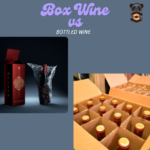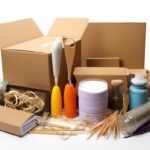The Power of Corrugated Boxes : Types & Benefits
Corrugated boxes is often confused with cardboard, and that causes a misunderstanding about its true benefits and usage. Many people just assume everything is the same, but there is a huge difference between cardboard and corrugated cardboard that addresses whether or not something can serve its purpose based on the need for that particular product.
In this article, we will compare and contrast cardboard with corrugated cardboard, review the features of corrugated packaging, discuss quality control, and list the advantages and uses. This will bring us to our conclusion regarding the understanding of corrugated packaging, thus leading you to choose the best option for your products’ packaging needs!
What is a Corrugated Box?
This box design uses sheets of packing material called corrugated cardboard to crate containerization. Owing to their strength, these boxes are greatly employed in transport packaging for large or heavy products. In fact, 95 percent of all products shipped in North America are packaged using corrugated materials!

And what is corrugated cardboard?
Corrugated cardboard, popularly referred to as corrugated fiberboard or corrugated cartons, is any material made with three layers of kraft paper, namely 2 outer layers as flat linerboard and 1 inner layer as fluted medium layer or wavy medium layer, an example of which will be pizza boxes. In special cases, the addition of outer layers can provide extra protection and will be discussed in due course.
Cardboard vs. Corrugated – What separates them?
Having grasped what corrugated packaging means and how prevalent it is in shipping, you may ask yourself what the difference is between corrugated and cardboard. Here, we have briefly mentioned that corrugated cardboard is not the same thing as cardboard. Cardboard generally consists of some stock paper or paper pulp, making it heavy-duty commercial-wise. It usually finds its niche in folded cartons for smaller products. Framing could also see intensive usage, particularly upon cardboard just to give shape to a box in transit. Yet cardboard by itself offers little protection.
Corrugated, on the other hand, makes the difference. It consists of three fiberboard layers, making it exceptional in durability, protective-ness, and versatility. It is a material that is resistant against bending and is considered one of the best alternative materials whether your company is shipping large packages or sending some products. Not still sure about the difference? Check out the comparison chart below!

Liners Materials
If you know a little more about corrugated materials, it should become easier for you to pick the most commonly used outside liner for the production of corrugated boxes.
- The primary composition of Kraft Paper liner is 70-80 percent “virgin” chemical pulp fiber, which is a principal property of this paper grade, rendering it highly stiff or low in flexibility and very durable. Its green articulation stands out among all kinds of corrugated paper materials, but it is the costliest of choices among them.
- Test Paper comprises much recycled fiber content, making it less expensive than Kraft. It becomes less durable though, and due to the high recycled fiber content, printing on this type of paper becomes difficult. However, test paper is commonly employed for usage as the inner linerboard of a corrugated box.
- Semi-Chem and Waste-based Fluting are types of Flute Liner Paper. Whereas Semi-Chem uses virgin fibers and a neutral sulphite semi-chemical process, Waste Based Fluting utilizes 100% recycled fibers.
Corrugated Flute Types (Flute Grades)
Depending on the different flute grades, the corrugated flute can provide cushioning, strength, and compression-resistance characteristics to your box, thus offering additional customization capabilities. However, before we get into an in-depth look at the flute profiles, take a glance at our corrugated flute chart for a quick visual comparison:
- Just above the A-Flute_1/4″ flutes, the largest size offers maximum protection and cushioning. Compression and stacking are handled very well by the A-Flute, which is why they are often chosen for packing very fragile products.
- The B-flute is 1/8″ thick and appears to be the thinnest of all grades, yet that impression belies its real strength. The B-flute has maximum, well-rounded general-purpose characteristics that lend themselves to a variety of uses, either singly or in combination, to cushion or separate items from one another. It also offers a flatter surface for high-caliber printing and easy die-cutting.
- C-Flute appears to be an inch thick and supple, widely regarded as one of the most versatile flute grades across a host of different kinds of corrugated boxes. It has average crush resistance, stacking strength, and printing properties. C-flute corrugated cardboard has probably seen service for packaging shipping boxes and glass, dairy, and furniture products.
- E-Flute-1/16 thick is not generally used for shipping. E-flute does lie on the thinner end of the flute grades, so it is an alternative medium for paperboard folding cartons. E-Flute may be used for cosmetics, fragile glass, ceramics, and other small and delicate items. E-Flute has good compression strength, crush resistance, and a semi-flat surface which enables high-quality printing applications.
- F-Flute-1/32 thick has similar protection effects to that of E-Flute and also offers an even smoother surface for high-quality printing. The F-Flute is common for clam shell packaging in the fast-food industry in the US, while in Europe this fluting grade is an accepted choice for specialty and retail packaging.
Types of Corrugated
Now that we’ve covered the different types of liners and flute grades, it’s time to look at combined board! Fluting and liners can be combined in different layers to create a variety of flute structures that have different thicknesses.
- Linerboard – The ‘face’ of the fiberboard sheet. You glue the flute onto this board.
- Single Face – Consists of one linerboard with the glued flute visible on one side. It is sometimes called corrugated paper.
- Single Wall – The most common thickness. Two sheets of linerboards with one fluted fiberboard glued in between.
- Double Wall – Three sheets of linerboard and two fluted fiberboards in between.
- Triple Wall – Four sheets of linerboard and three fluted fiberboards in between. This option can withstand heavier weights up to almost 300 lbs but is less flexible.
With the addition of more details, some double and triple wall walls will allow further combinations of flute grades. Some are considered to be standard combinations in the industry:
- For about the harshest shipping and handling processes, one would want to be looking for something even more protective than a combination of these two very protective corrugated grades- therefore, they would need AC flute.
- BC flute-the all-around performer-combines high transit protection with wide shipping box applications.
- EB flute-transit protection and strength combined with an excellent surface for high-quality printing provided by the outer E-Flute.
Corrugated Box Styles
Approaches to quality control will soon follow discussion on types of boxes, construction, and thickness. When combining materials, selecting flute grades, and padding, corrugated boxes can meet any need in packaging.
Custom corrugated boxes meet any specific requirement of the user. Some common types of corrugated boxes include:
- Tab Lock Roll End
- Roll End 3 Flaps Tuck
- Roll End Tuck Front
- One Piece Folder Box
- Tuck Top Auto Bottom
- Regular Slotted Box
- Full Slotted Box
- Half Slotted Container (HSC Box)
- Gusset Folder
Quality Control Tests
There are so many design and customization options in the world today that many questions may arise in your mind regarding protection. Corrugated boxes undergo stress and impact during the packing, shipping, and storage processes, so it is imperative to test the strength of your custom packaging design.
Common tests include Edge Crush, Flat Crush, and Burst Test.
- One of the main tests for corrugated cardboard is the Edge Crush Test. As the name suggests, here one applies the force perpendicular to the edge of the corrugating cardboard until it slips. This test result ensures the strength and durability needed to withstand heavy loads and stack resistance.
- The Flat Crush Test is also performed in conjunction with the Edge Crush Test. The force is applied directly onto a surface area of the corrugated cardboard until the flute is flattened and its structure compromised. This test similarly measures the compression and stacking resistance of the corrugated cardboard that is needed to carry heavy loads.
- Also called the Mullen Test, or Burst Test, it measures, as an industry standard, the performance of the corrugated surface by measuring the force required to pierce through the board.
Quality assurance tests all these of custom designed corrugated packaging making sure your products are secured enough with the safety they need throughout their transportation unto the final destination.
The Benefits of Corrugated Packaging
By now, you probably have some ideas as to the benefits of corrugated packaging. Still, what makes corrugated cardboard such a popular packaging option?
- The corrugated boxes provide protection and resistance, which are highly beneficial for transit. Impact-resistant and buffered, these boxes are appropriate for shipments. Other than being unbothered with vicious weather conditions, they provide maximum protection from the elements, duly qualifying them for packaging applications.
- Sustainable – Over the past ten years, sustainability has picked up quite a lot of attention, especially with regard to packaging. Corrugated cardboard is one of the most often No industry exists without benefiting from corrugated packaging, particularly the e-commerce sector. Depending on the type and shape of the packaging, it may ease shipping and mailing considerably. Otherwise, using corrugated boxes also comes with some downsides. Considered packaging options since they are made from recycled fibers that allow for easier recycling.
- Customizable- There are many raw materials available and many ecological considerations to take into account concerning custom packaging corrugated packing is best suited for anyone wanting a package if printing is to be considered. It is readily compatible with graphic and surface printing for varying shapes and thicknesses.
What About the Disadvantages of Corrugated Boxes?
- Weather Resistance Is Limited: Corrugated boxes are vulnerable to acts of nature besting their strength, rain or snow, thus irrevocably deforming their shape.
- Cost Considerations: A further drawback to the use of corrugated cardboard is its expense. Costing vastly more than other options, such options are expectedly more expensive due to COVID-19 disruptions in supply chains and also the introduction of environmental regulations designed to curb deforestation and promote sustainable forestry.
These cons can discourage any company with a lower budget. But such disadvantages must be compared to the advantages in terms of protection, recyclability, and versatility. Another aspect here is the various ways considered to keep costs down and achieve affordable luxury packaging!
Create your custom corrugated boxes
Unlimited design possibilities are offered with the strength and flexibility of cor-Ruff packaging, creating a custom box that will protect the product in transit. Contact our experts and talk to them for further information, and get started with your project today!







